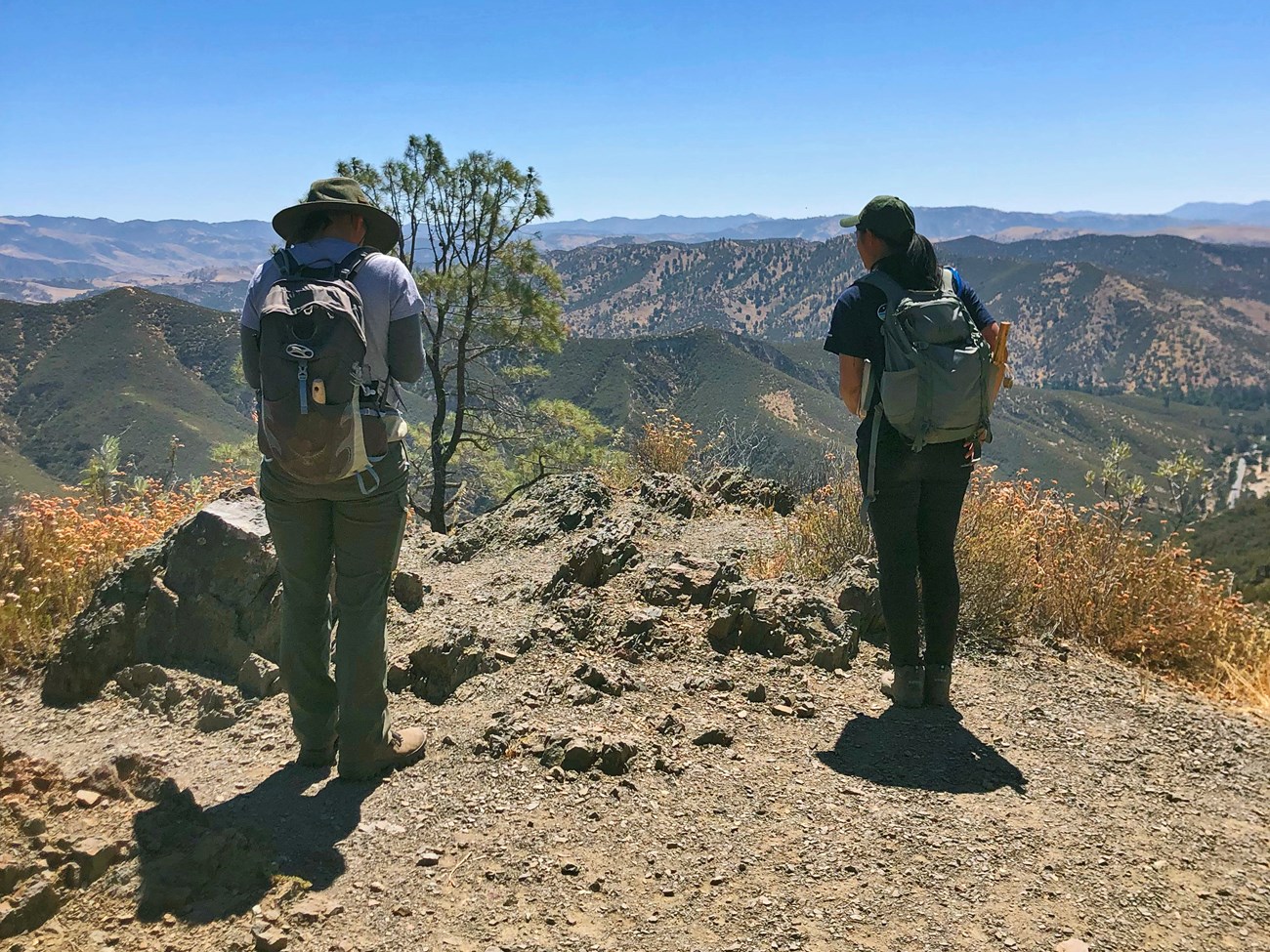Last updated: July 8, 2025
Article
Botany News – Spring 2022
Issue compiled by Plant Community Monitoring Intern Alexandria Knoell, San Francisco Bay Area Network Botany Program
Getting to Know the SFAN Botany Team
Beyond the breath-taking hikes, beaches, and views that give Bay Area national parks their claim to fame lie incredibly diverse plant communities. Since 2013, National Park Service botanists, seasonal technicians, interns, and volunteers have established and revisited over 150 permanent plots throughout the network, building a baseline for long-term data collection. This summer's botany team has hit the ground running, enjoying field snacks on the hillsides of Tennessee Valley and sleeping beneath the stars in Pinnacles National Park.

Courtesy Sarah Johnson
Katherine Stratton
ISED Crew Lead
Katherine was born in the heart of the midwest: Iowa City, Iowa. Growing up in the state with the lowest percentage of public lands, she spent much of her childhood fishing at the fortuitously nearby state park, but soon found herself dreaming of more variable topography. So, like many other Midwesterners, she headed west.
She has worked on a wide variety of natural resource projects throughout the Pacific Northwest and Intermountain West, including propagating conifers for national forests, establishing new seed transfer zones for great basin forbs, gauging the efficacy of fuel breaks, and urban ecological restoration.

NPS / Alee Knoell
Brett Stormoen
PCM Crew Lead
Brett grew up exploring the foothills and creeks in the Southern Coast Ranges around Santa Barbara, CA. He took to environmental stewardship and plants through observing the vegetation on these landscapes and by working as an apprentice on an organic farm, and then went on to study plant sciences.
Brett worked in native plant horticulture and ecological restoration, and has since moved more towards performing vegetation and wildlife surveys in science technician roles. He has studied many California plant communities from the wetlands bordering the San Francisco Bay to the chaparral at the peak of Mt. Diablo. He was an intern for the SFAN Botany Team back in 2019, and is excited to be back to lead the PCM program now.

Courtesy Shannon Dunnigan
Alexandria Knoell
PCM Intern
Born in San Diego, California, Alee has moved several times throughout her childhood. These family road trips to and from new destinations across the country planted a seed of deep appreciation and wonder for nature early on.
Her career path down the road of research began in Florida, leading her to a job at a research reserve working on various long term monitoring projects. Of these, she enjoyed studying the saltmarsh vegetation the most. That cultivated interest in plants coupled with an early installed itch to travel brought her here to San Francisco to become this summers PCM intern.

Courtesy Amy Nguyen
Yvonne Ng
ISED Intern
Yvonne was raised and accustomed to the city-dwelling parts of the Bay Area. Her appreciation for nature comes from fond memories hiking with her friends, watching shorebirds at the beach, and sneaking off to take a dip in the ocean.
In the last year and a half, she has worked in habitat restoration, bird monitoring, and on a research project with a combination of both! With growing curiosity for the opportunities in the field, Yvonne found herself as an ISED intern.
NPS / Alee Knoell
Lisa Schomaker
Botanist
Lisa was born in Seattle, Washington, and her fondness for the great outdoors developed from a childhood filled with camping and backpacking trips. Her involvement in research began in Portland, Oregon studying the impacts of air pollution on Douglas-fir forest, and the desire to continue working in and with nature has driven her to a variety of different projects and places. From invasive species removal in California to counting sockeye salmon in Alaska, she now leads her team of botanists through the San Francisco bramble to build upon the trove of NPS baseline vegetation data. Read the entire scientist profile here.
Spring Surveys
ISED
Marin Headlands, Golden Gate National Recreation Area
The ISED team began their field season by surveying the trails of the Marin Headlands. Throughout the past month, they have covered Homestead Valley, Gerbode Valley, and most of the trails between Muir Beach and Tennessee Valley. Noteworthy detections this season include Arctotheca sp (capeweed) and Centaurea melitensis (tocalote) (see below). Of these, eight capeweed records and 11 tocalote records were new occurrences to the area. Conversely, Helichrysum petiolare (licorice plant), which was once prolific in the headlands, appears to be being successfully managed as it has not yet been sighted by the ISED crew this monitoring season.

NPS / Alee Knoell

NPS / Alee Knoell
Pinnacles National Park
The entire botany team was very excited to get out to Pinnacles National Park mid-June to hunt down and document some invasive plant species. With the PCM and ISED teams both working toward this common goal, they were able to survey over 16 miles, recording 38 priority 1 and 2 invasive species. They treated some particularly pesky ones, such as some occurrences of Centaurea solstitialis (star thistle), by manual removal. Along with invasive species scouting, the botany team thoroughly enjoyed getting to explore SFAN’s southernmost region, taking in all of the beautiful views, trails, and caves that the park has to offer.

NPS / Alee Knoell
PCM
The PCM team will monitor plots in southern coastal scrub, northern coastal scrub, freshwater wetland, coastal salt marsh, and Douglas-fir forest in 2022. In April, May, and June, we visited all southern coastal scrub plots in Pinnacles and several northern coastal scrub plots throughout Golden Gate and Point Reyes National Seashore. The southern coastal scrub delighted us with easily-accessible plots, hillsides of blooming Eriogonum fasciculatum var. foliolosum (California buckwheat), many delicate Clarkia, and the occasional California condor sighting. Despite battling thick masses of Toxicodendron diversilobum (poison oak) in the northern coastal scrub back at Golden Gate and Point Reyes, the team has succeeded in data collection at these sites as well, restarting the monitoring cycle for a community that was last visited fully in 2015. While each northern scrub plot is fairly diverse, the two species that most commonly come into contact with our probing point-intercept flag are Artemisia californica (California coast sagebrush) and Baccharis pilularis subsp. consanguinea (coyote brush).
We observed that some annual forbs collected in Pinnacles this year were shorter in height and had less biomass overall than the same plants collected here in the past, despite being in the same phenological stage (generally fruiting or senescing by the time we encountered them). We speculate that rain early in the year followed by a very dry winter and spring may have stunted plant growth in some areas.
Noteworthy Early Detections
Capeweed
(Arctotheca spp.)

Patrick Hoffman / Arctotheca calendula / 2021-04-29 / Calflora.org / CC-BY-NC 4.0
Capeweed continues to thrive within the Marin Headlands. Thirty-three patches of the prolific weed have been observed along the trails so far in 2022, one third of which are new occurrences.
While our sightings of Capeweed have been confined to the Marin Headlands, the plant has been observed by Weed Watcher collaborators throughout Point Reyes and occasionally near Mori Point.
There are two species of capeweed we look for: fertile and creeping capeweed. As the names describe them, one reproduces through fertile seeds and stolons, while the other only expands itself with its stolons. Both look similar and low-growing, forming a basal rosette with heavily lobed leaves with yellow, daisy-like flowers. Fertile capeweed flowers from March to August while creeping capeweed flowers year-round. How we tell the differences between them is by the colors or shades of their disc flowers, under the flower heads, and ray flowers.
Capeweed is native to South Africa, but is commonly found throughout northern California and the Bay Area, favoring coastal prairies and dunes. Creeping capeweed is an ornamental plant, but it often escapes its intended homes.
Resources:
Tocalote
(Centaurea melitensis)

Jordan Zylstra / 0000 0000 0706 1375 / 2006 / calphotos.berkeley.edu / Public Domain
Tocalote is another common sighting from the Coastal Trail in the Marin Headlands to far-flung locales like the John Muir National Historic Site. So far, the ISED crew has located 28 occurrences of Tocalote, of which eight are new to the park system.
Tocalote can displace native plants by producing a large seedbank to outcompete its neighbors. Each individual Tocalote plant may have up to 100 flowering heads, which each produce up to 60 seeds. These seeds not only colonize the area surrounding existing infestations, but can easily stick to clothing, animals, and vehicles to travel far and wide. Notably, ingestion of Tocalote by horses and other grazers can lead to a neurological condition known as “Chewing Disease.”
Tocalote is one of the smaller, less spikier of the thistles that can be found. From the basal rosette at its base, flower heads branch off from the stem where the leaf connects. It has yellow flowers that occur in April to July with a round and cobweb-like body that contains small spines in pale to purple colors.
Tocalote is native to the western mediterranean region, but can be found all throughout California and along the western and southwestern coastal states and do well in open and disturbed areas.
Resources:
Native Species Spotlight
Yerba Buena
(Clinopodium douglasii)

NPS / Alee Knoell
While not the most abundant plant within our scrub plots, it certainly competes for the title of most pleasantly scented. The small, sharply-scented leaves are in fact edible, and have been used as an herbal remedy for conditions such as digestive disorders, allergies, insect bites, and nausea.
When in bloom (April - September), C. douglasii is adorned with small white to lavender flowers. It is a mat forming herb with woody stems and small, ovate leaves, oppositely arranged, with shallow rounded margins.
C. douglasii is native to California as well as Oregon, Washington, Idaho, Montana, and even extending up into British Columbia. It has also been introduced to Alaska. C. douglasii favors shade, and tends to thrive in northern coastal scrub, woodland, chaparral, and sometimes wetlands.
Resources:
May and June ISED Survey Results
This month's ISED records may be viewed in an interactive map at the Calflora Observation Search website. Navigate to the Help Site for assistance using the Observation Search page.
